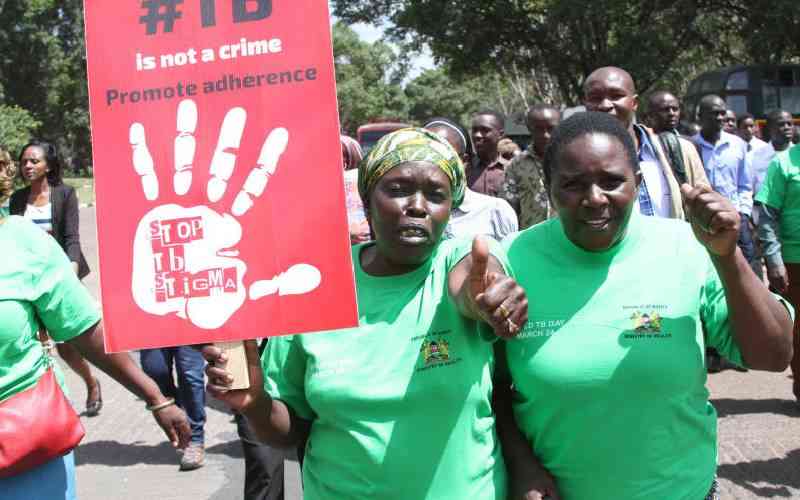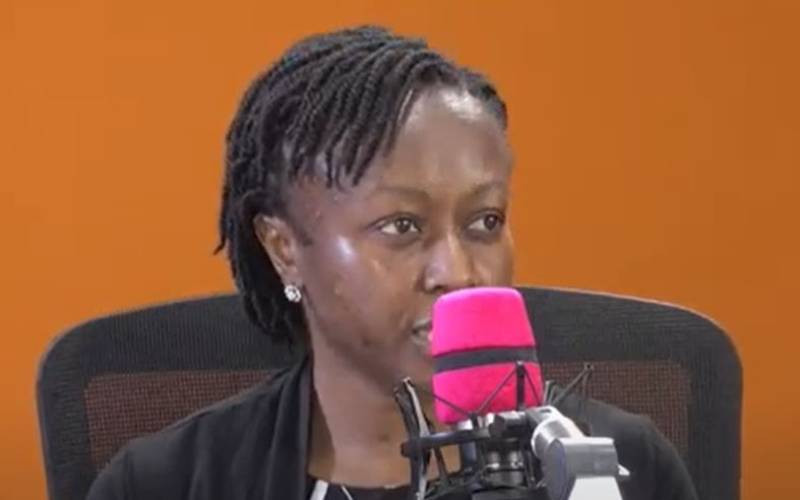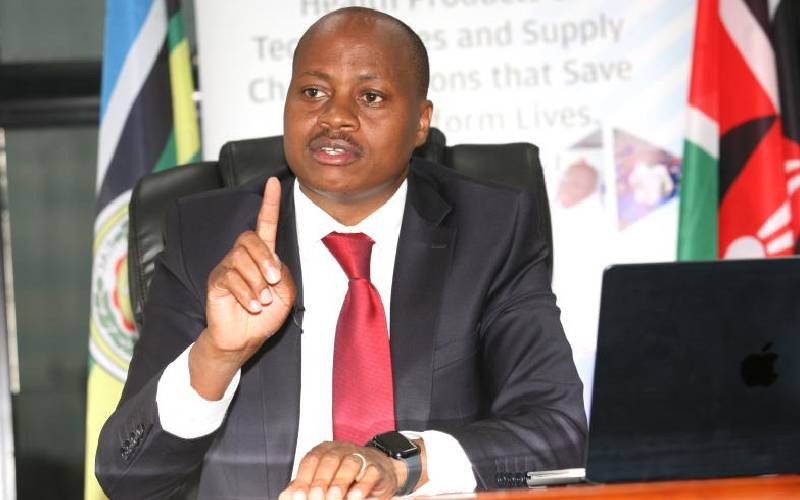 Daniel Lolwak, a resident of West Pokot County who has been informed that he will be blind in a couple of months. [Photo: Paul Wafula/Standard]
Daniel Lolwak, a resident of West Pokot County who has been informed that he will be blind in a couple of months. [Photo: Paul Wafula/Standard]
By Paul Wafula
Kenya: Daniel Lolwalk is living on borrowed eyesight. Doctors have already warned him that in a few months time his world will turn pitch dark.
The-32-year-old resident of West Pokot County will no longer be able to see his modest home, his goats and his mother, the woman who has stood by him through thick and thin.
There is nothing anyone can do to stop his descent into eternal darkness. Not even the only eye surgeon available in his county can help him. For Lolwalk has, in the past 24 years, already lost more than a half of his eyesight. Doctors say it would take a miracle to reverse it. What’s worse is that Daniel did not know the fate that awaits him.
Lolwalk, who lives with his mother in Thakar, a small village about 40 minutes from Kapenguria town is now learning to use a walking stick. His failing eyesight recently forced him to shelve his marriage plans.
A fresh wound is developing where his cornea is supposed to be. Speaking in short sentences, Lolwalk says he has not been to a hospital nor seen an eye specialist in the past five years, when his sight deteriorated the most.
Daniel did not blink even once during our three-hour interview. But the man, who spends most of the staring into darkness, expressed hope that one day he would regain his eye sight.
But this was shattered the next day, when he met an eye surgeon, who serves a population of 2.3 million people in the county. West Pokot shares an eye surgeon with Turkana and Trans Nzoia. Dr Hillary Rono, the region’s eye surgeon arrived early the next morning. Rono is based in Kitale town in neighbouring Trans Nzoia County.
It didn’t take long for the doctor to diagnose and break the bad news.
“It’s too late,” he said. “An operation cannot help him. He has full blown trachoma, grade 3, and it’s beyond the stage we can help him.”
He added: “He will definitely go blind and there is no need of an operation.”
That struck Lolwalk like a thunderbolt. As the news sunk in, he looked away, of course unseeingly, in disbelief and shock. That was the last time he spoke to us.
Lolwalk’s fate had been sealed. Soon he will join the over 215,000 blind people in Kenya.
Lolwalk is suffering from trachoma, a neglected tropical disease and one of the biggest health burdens of West Pokot County.
Each of the seven villages we visited in West Pokot has someone who has been blinded by the disease or is on his way to blindness. The disease is quietly blinding children and their parents.
One in every four children between one and nine years in Lolwalk’s county has active trachoma. There are at least 10,000 other Lolwalks in West Pokot.
Donors
Surprisingly, the whole of West Pokot, with a population of over 526,000 residents, has no eye surgeon. What’s more disturbing is that the county government is not planning to hire any eye surgeon during this financial year with its Sh3 billion budget cash.
The government will also not take over the efforts to fight the disease. This will remain in the hands of a donor, The Fred Hollows Foundation, which with very little help from the previous governments has been intervening in the region.
The county has allocated just Sh300,000 to buy a single machine to support eye operations. This means that West Pokot, which plans to spend about Sh706 on each of its citizens this financial year on health, will continue to share one eye surgeon with Turkana and Trans Nzoia counties.
Although West Pokot has other pressing issues from poor roads, education and a huge burden of other diseases made worse by decades of neglect, just why didn’t the county government hire even one surgeon to battle trachoma?
“We cannot have surgeons in this county because we do not have theatres. We do not have specialised doctors because they can come here but fail to get the facilities,” Mr Titus Lotee, the Deputy Governor.
Though this may be true for other conditions, a trachoma operation requires a simple theatre that is already available.
“Diseases such as trachoma do not wait for you to get budgets. Surgeries also must be done at the right time to be helpful. But counties are treating health as a by-the-way, just inheriting the same way of doing things,” said Dr Sultani Matendechero, the secretary general of the Kenya Medical Practitioners, Pharmacists and Dentists Union (KPMDU).
The union recently called its members to a national strike protesting lack of equipment in public hospitals. KPMDU has also been opposed to devolving health services. West Pokot is not the only county that is yet to respond to local health challenges that were neglected by previous governments.
It was expected that after devolution, county governments would be best placed to address grassroots challenges, but it appears most counties are yet to do this. Decentralisation of investments in health, it was hoped, would allow counties to spend more strategically to solve the most pressing healthcare needs in their areas.
Bilharzia
But an examination of the county budgets and priorities reveals that county governments are failing the test of investing innovatively and have continued to follow the old national strategies and priorities. As a result, counties continue to isolate many needy citizens, like Lolwalk, who they were supposed to uplift.
For instance, it was expected that counties in the Lower Eastern and the Lake basin regions would pay special attention to bilharzia, counties in the arid and semi-arid areas were expected to tackle trachoma and kala-azar while counties at the Coast were expected to pay closer attention to elephantiasis. This has not been the case.
Kilifi County is yet to come up with any tangible plan to fight elephantiasis. Tharaka Nithi has yet to develop a comprehensive health plan more than eight months after the election. The county secretary of health, Ms Magdalene Njeri, could not tell how much money was allocated for health development.
Though the amount of money spent on any sector does not necessarily result in better service delivery, development budgets are good tools to measure the priorities of the new county governments.
An analysis of the development health budget lines of the 47 counties against a set of nine indicators, that would ordinarily be considered in any evidence based spending plans, further confirmed suspicions about a lack of an informed health policy.
The indicators chosen to determine healthcare funding needs included population density, HIV prevalence and reported malaria and TB cases for every 100,000 people. The number of doctors, nurses and clinical officers serving 100,000 people as well as the total public health facilities in each of the counties were the other indicators captured in our data analysis.
A scrutiny of the county budgets revealed that there was no link between the planned health spending and this set of indicators in most of the counties. To establish a relationship between healthcare needs and spending allocations, the model we used would return a score of 95 per cent or more. But the strongest link was 58 per cent.
There were even some counties that returned a negative result, raising a question on just what parameters were used in the budgeting process.
In our model, the Ministry of Health data, Kenya Health at a Glance, together with data from the Commission on Revenue Allocation’s Kenya County Fact Sheet 2013, were used to calculate the factors considered in budgeting.
An analysis of the data showed that factors like existing number of hospitals, staffing, surface area of the county and the disease burdens were not taken into consideration while allocating budget for health. Only population size was considered by the counties.
Workshop
A weighted mean would put into consideration the population density component, disease incidences component, the staffing component and health infrastructure component.
A visit to more counties revealed a rushed budgeting process, developed by people who were just days into the office, some with no previous budgeting experience.
“Unfortunately for our budget, we were just told to attend a two-day workshop to make the budget for approval for the different line ministries. That is how it went. We were just told here you are, you need to provide this budget this week, within these limits,” Dr Swabah Omar, Kilifi County health secretary said.
“Of course the best would be to look at the demands within the county and based on the strategy one would want to undertake, allocate appropriately for each activity,” said Omar.
Our findings were corroborated by an analysis by International Budget Partners (IBP), an independent organisation that specialises in scrutinising budgets around the world.
“Towards the end of June 2013, county governments raced to complete and approve their 2013/14 budgets in order to meet the June 30 deadline set by the Public Finance Management Act,” Mr John Kinuthia, an analyst at International Budget Partners (IBP) told the Standard.
In its first independent analysis, IBP noted that the first year of proposing and approving county budgets has been marked by considerable confusion.
“But as they rushed to meet these deadlines they may have failed to spend enough time to align their budgets to the right priorities. Analysing the data, you get a feeling that most just did what the national governments did last year,” Mr Kinuthia said in his analysis.
Our two-month data-driven investigation, which also led us to Tharaka Nithi and Kilifi Counties, revealed that most counties did not factor in the nature of challenges inherited from the previous regimes, some that had been neglected for decades, in their first budget.
Through this series, The Standard from today will lay bare the state of health in the 47 devolved units. The series also interrogates the county budgets and will expose the worst spenders on health while highlighting the most responsive counties.
Using the data, we have also developed the first ever news application for you to find out how much your governor has invested in improving your health this year on our Standard digital platform. The news application, the very first by a local media house, will also allow you to interact with your county health data.
Additional information on how counties spend on health http://www.standardmedia.co.ke/health/changeforhealth
 The Standard Group Plc is a multi-media organization with investments in media platforms spanning newspaper print
operations, television, radio broadcasting, digital and online services. The Standard Group is recognized as a
leading multi-media house in Kenya with a key influence in matters of national and international interest.
The Standard Group Plc is a multi-media organization with investments in media platforms spanning newspaper print
operations, television, radio broadcasting, digital and online services. The Standard Group is recognized as a
leading multi-media house in Kenya with a key influence in matters of national and international interest.











